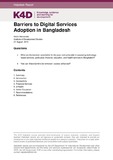| dc.contributor.author | Hernandez, Kevin | |
| dc.coverage.spatial | Bangladesh | en |
| dc.date.accessioned | 2019-09-03T16:20:30Z | |
| dc.date.available | 2019-09-03T16:20:30Z | |
| dc.date.issued | 2019-08-01 | |
| dc.identifier.citation | Hernandez, K. (2019). Barriers to Digital Services Adoption in Bangladesh. K4D Helpdesk Report 573. Brighton, UK: Institute of Development Studies. | en |
| dc.identifier.uri | https://opendocs.ids.ac.uk/opendocs/handle/20.500.12413/14677 | |
| dc.description.abstract | This report uncovered many barriers to digital services in Bangladesh with a particular focus on access to digital connectivity, digital financial services, e-health, and online education. The 5 As of technology access were used as a framework to uncover barriers across these areas as well as connectivity. The report found significant barriers to the use of digital services regarding availability, affordability, awareness, ability, and agency across connectivity and the three digital service areas. The findings of the 5 As analysis are summarised as follow. First, 97% of Bangladesh is covered by a mobile signal. However, not everyone has continuous access or access to the same speed (e.g. 2g, 3g, 4g). 97 % of Bangladesh is covered by a mobile signal. However, not everyone has continuous access or access to the same speed (e.g. 2g, 3g, 4g). Second, Mobile phone ownership and connectivity eat up a greater share of income for the poor. Although bKash, Bangladesh’s leading mobile money providers is inexpensive when compared to mobile money providers in other countries and does not burden the poor with regressive pricing strategies, people living below the poverty line are still less likely to use it. Third, 67% of people in Bangladesh do not have Internet awareness (LIRNEasia 2018). Awareness is also low for digital services. Fourth, not knowing how to use the Internet is the main barrier they faced by 67% of offline Bangladeshis. Fifth, women are less likely to be mobile phone owners and Internet users than men globally (ITU, 2017). This trend is especially pronounced in Bangladesh where 58% of women vs. 87% of men own mobile phones (a 34% gap) and 7% of women vs. 18% of men use the Internet (a 62% gap) (After Access 2018b). | en |
| dc.language.iso | en | en |
| dc.publisher | IDS | en |
| dc.relation.ispartofseries | K4D Helpdesk Report;573 | |
| dc.rights.uri | https://www.nationalarchives.gov.uk/doc/open-government-licence/version/3/ | en |
| dc.subject | Technology | en |
| dc.title | Barriers to Digital Services Adoption in Bangladesh | en |
| dc.type | Helpdesk | en |
| dc.rights.holder | © DFID - Crown copyright 2019 | en |
| dcterms.dateAccepted | 2019-08-01 | |
| rioxxterms.funder | Department for International Development, UK Government | en |
| rioxxterms.identifier.project | K4D | en |
| rioxxterms.version | VoR | en |
| rioxxterms.funder.project | 238a9fa4-fe4a-4380-996b-995f33607ba0 | en |

